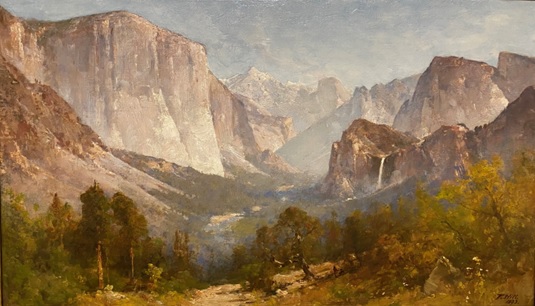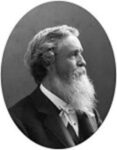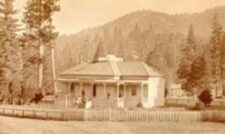
Thomas Hill
American, 1829-1908
View of Yosemite Valley, 1893
oil on canvas
19 3/4 x 29 3/4 in.
SBMA, Gift of Donald and Jobeth Van Gelderen in honor of Richard West
1991.96

Photograph of Thomas Hill, Wawona, July 15, 1906, by I.W. Taber
RESEARCH PAPER
"View of Yosemite Valley" is one of many paintings in and around Yosemite that Thomas Hill painted in his lifetime. Completed in 1893 when he was sixty-four, it is one of his last paintings of Yosemite Valley. Majesty and splendor were the hallmarks of Hill’s natural landscape works. This work is especially stunning because it presents one the most spectacular natural vistas in the world. Like most of his other nature landscapes, it was done with easel, canvas, and oil paints “en plein air.”
The work depicts the grandeur of Yosemite Valley, letting the natural setting express itself. The sunlight to the left and shadows to the right create dramatic contrasts and esthetic balance. There are textural contrasts as well, with granite domes and jagged stone peaks in the sharply focused background, versus the softness of the forest foreground. Strong vertical, horizontal, diagonal lines make for a composed presentation. Overall, the painting is serene and peaceful, but tension is created by cascading waterfall centered slightly right, and the snow covered peak higher up and left of center. This tension is resolved by the flowing river in the middle of the panorama that fades away into the valley below.
"View of Yosemite Valley" was painted from a location just above the pubic area today known as Wawona Tunnel View. It is the first view of Yosemite Valley seen by Park visitors after they exit the long tunnel entering the Park. The magnificent view looks eastward into the Valley, and includes surrounding features, such as the southwest face of El Capitan on the left, Half Dome on axis, Bridal Veil Falls on the right, and the Merced River at the lower middle. Many iconic paintings and photographs of Yosemite Valley have been created from this same area.
This painting was completed at a time when America was moving rapidly westward after the gold rush and the winning of the Mexican War. America’s “Manifest Destiny” could have only been further activated by paintings like this one promoting the great beauty of the country’s western areas.
In 1903, Hill’s painting of "Yosemite, Bridal Veil Fall", was given to President Theodore Roosevelt. Another painting from Hill created in 1865, with the same title, "View of Yosemite Valley", was the backdrop of the head table at Barack Obama's inaugural luncheon to commemorate the 1864 signing of the Yosemite Grant by President Abraham Lincoln.
Hill was versatile in style, ranging from very tightly executed ultra-realistic paintings to spontaneous brushstrokes of both strong and subtle coloring. He developed extremely realist techniques for depicting light and weather, accounting for his atmospheric renderings that present true-to-life views of nature. He was a prolific painter who was known for the speed in which he created paintings. He painted more than 5,000 works of Yosemite Valley.
Artists of Hill’s period often reflected this philosophy in their landscape renderings. This group regarded natural beauty and the painting of landscapes as a spiritual quest. Hill may not have held the same philosophical aspirations, but he strove for the same visual effects.
Landscape paintings from this era in California history were meant to make the viewer feel connected to the land and the environment around them. Paintings by these artists served to motivate care for nature and have inspired generations of environmentalists. John Muir, the famed naturalist, was a friend of Hill’s, and he secured a commission for Hill to paint Muir Glacier in Glacier Bay, Alaska.
Thomas Hill was born in Birmingham, England on September 11, 1829, coming to the U.S. in 1844. During the 1850’s Hill painted in Massachusetts and often in the White Mountains of New Hampshire often with Albert Bierstadt, another renowned American landscape painter.
For health reasons he sought a milder climate that the Eastern United States did not accommodate, so, with wife and children, he moved to San Francisco in 1861. After establishing a home and studio, he made his living as a portrait painter. The next year he made his first trip to Yosemite. He was struck by the sheer beauty and magnificence of it all and began painting there. In 1866 he exhibited his Yosemite scenes at the National Academy. For many years thereafter he painted in Yosemite and in other naturally picturesque parts of the United States. In 1883 he built a studio in Yosemite where he sold his paintings to Park visitors. For his remaining years, the studio was his home, except for the winters when he returned to live in the San Francisco Bay Area. His studio in Yosemite is still there today, next to the Wawona Hotel, and serves as the Wawona Visitor Center.
Prepared for the Santa Barbara Museum of Art Docent Site by Manuel Rangel, 2023
BIBLIOGRAPHY
Thomas Hill (1829-1908) . sullivangoss.com. Retrieved 3 August 2020.
Driesbach, Janice T. Direct from Nature: The Oil Sketches of Thomas Hill. Sacramento, CA: Crocker Art Museum, 1997. https://www.google.com/url
https://lagunaartmuseum.org/artist/thomas-hill/
http://www.undiscovered-yosemite.com/yosemite-painter-thomas-hill.html
https://localwiki.org/oakland/Thomas_Hill

Hill's Studio in Wawona, Yosemite, photograph by George Fisk, 1866
